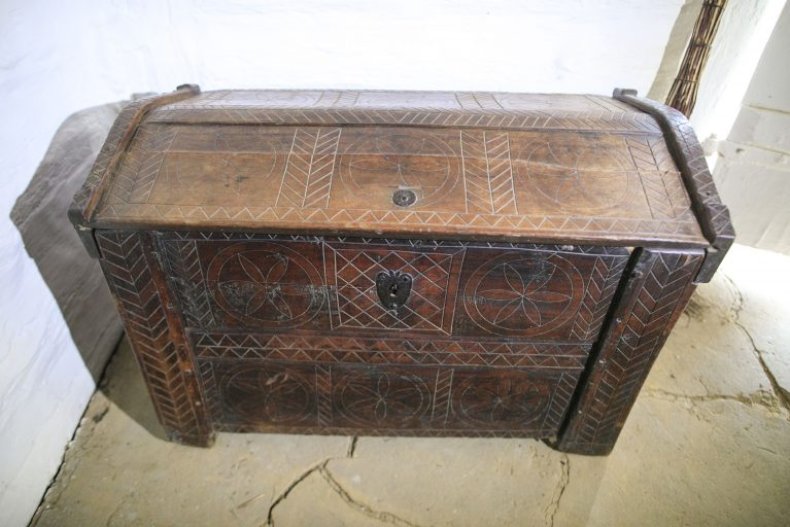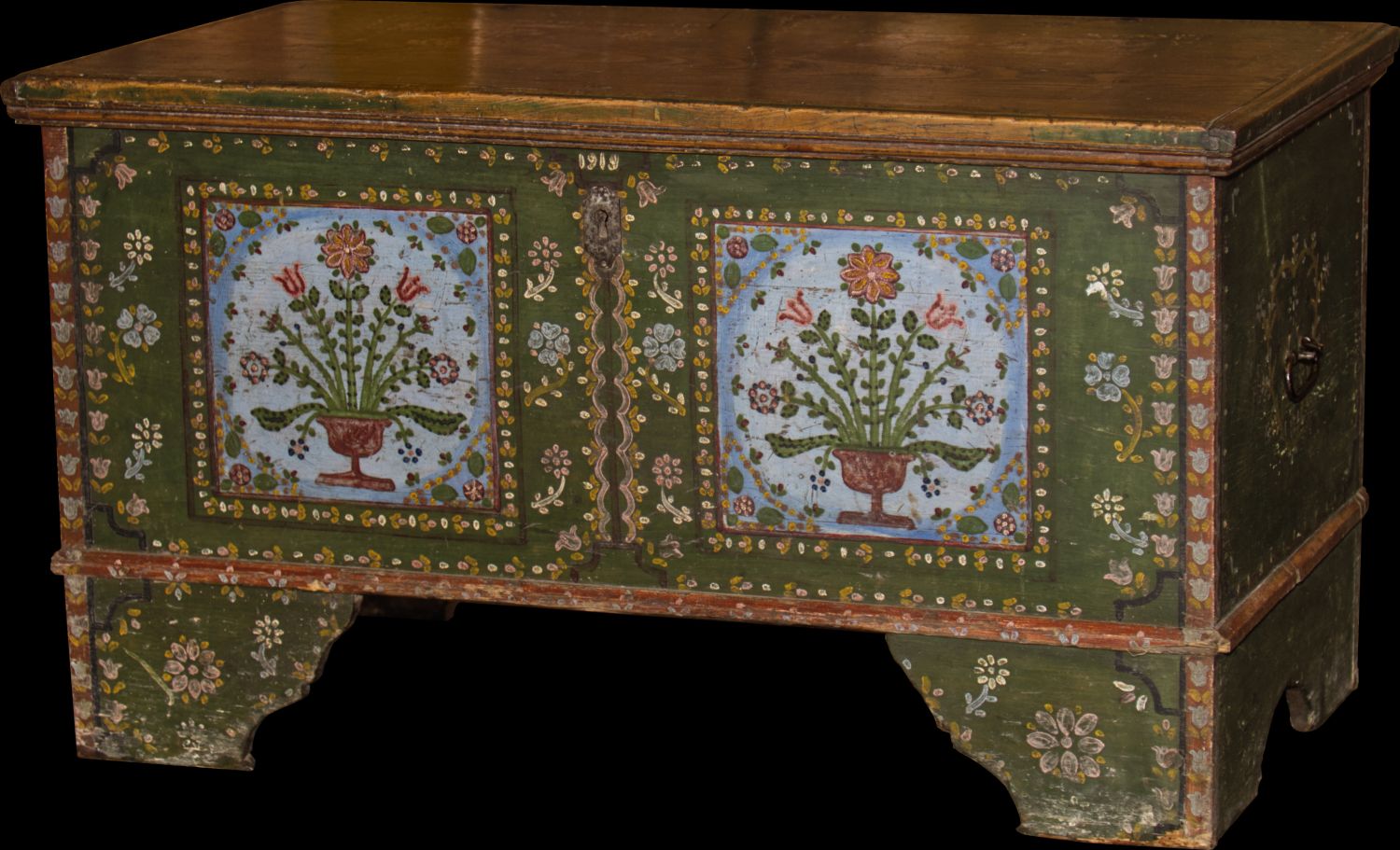Exhibition
Chests
A chest is a piece of furniture that began to be used in the countryside in the 18th century, but only in the next century did it become a permanent and common element of every cottage. She was indispensable in the bride's dowry. We invite you to the exhibition of dowry chests from the collections of the Sądecki Ethnographic Park and the Pieniny Museum in Szlachtowa.

Usually the chest was the only painted piece of furniture in the room. Beautifully decorated, most often with wide, fanciful bouquets of flowers composed on a colorful background, it stood in a visible place, next to simple peasant equipment - a table, benches, a bed or a shelf for dishes, it stood out in the foreground. It was mainly used to store women's clothing, tablecloths, bedding, devotional items, valuables, documents, money and family heirlooms.
She also played another role. For years, dowry for marriage, testifying to the wealth and thriftiness of the bride, was collected in it.
The wreath chest was the most personalized piece of furniture, inextricably linked with one woman, accompanying her from her youth to the grave. Only she had the key to it. If three generations of women lived in a rich cottage, each had its own chest, and the housekeeper's chest was the most important. In poorer households, a young bride would take over her grandmother's chest.
At the end of the first half of the 20th century, the chest began to lose its importance. It was no longer part of the bride's dowry, it was no longer the only place to store festive clothing. It was replaced with a wardrobe and ceased to occupy an exposed place in the room.
She also played another role. For years, dowry for marriage, testifying to the wealth and thriftiness of the bride, was collected in it.
The wreath chest was the most personalized piece of furniture, inextricably linked with one woman, accompanying her from her youth to the grave. Only she had the key to it. If three generations of women lived in a rich cottage, each had its own chest, and the housekeeper's chest was the most important. In poorer households, a young bride would take over her grandmother's chest.
At the end of the first half of the 20th century, the chest began to lose its importance. It was no longer part of the bride's dowry, it was no longer the only place to store festive clothing. It was replaced with a wardrobe and ceased to occupy an exposed place in the room.
There were two types of chests in the Nowy Sącz region and in the Pieniny and Ruś Szlachtowska. The older ones are chests made of hard wood (usually beech) using the carpentry technique. Their walls were connected "on a pole", the lid usually had the form of a gable roof, hence the term "sarcophagus" chests. They were decorated with a fluted geometric ornament, in which the motifs of a compass rosette and herringbone were characteristic. The younger type of chests had sides joined in the corners with corners and legs made of decoratively cut boards. Most were rectangular in shape. The boards for them were cut from thick trunks of coniferous trees, so that they were as wide as possible and did not need to be glued. For half-boxes (inside) thinner half-inch boards were used. This type had a flat lid, usually made of two or three boards, covered with a strip on three sides. Chests were sometimes painted in one color, most often green or brown, but usually they were decorated with polychrome, particularly rich on the front wall and lid. The painting of the chests was borrowed from Renaissance furniture making. It was popularized by small-town and rural carpenters. Glue or varnish paints were used for painting. The local fashion had the most important influence on the appearance of the furniture.
The older type of chests found in the Pieniny Mountains is characterized by a dark green background, on which two symmetrical flower fields are painted, it refers to the Spiš type chests. In the newer types, Podhale influences are noticeable - three symmetrical fields of bouquets in red on a dark green background, and Stary Sącz with three flower fields in yellow. The chests of the Nowy Sącz highlanders were usually decorated with two bouquets, often placed in pots or vases on a uniform background. The most popular among the Lachs were paintings with extensive stylized flower bouquets on two separate decorative fields. Sometimes inscriptions with the name, surname and wedding date of the bride were placed on the face or inside of the lid of the chest.
Residents of the villages of Nowy Targ and Pieniny purchased dowry chests in carpentry centers in Stary Sącz, Limanowa, Łąck, Piwniczna, Nowy Targ and Spisz, and they were also made by local carpenters.
The women kept their festive clothes in the chest. They filled them with heavy skirts made of cotton yarn, the so-called "kanafoskas", linen "dybetki" dyed with blue print and light, colorful "tybetki". The chests held linen shirts with "streaks" and hems, as well as white, linen shirts with a small ruff, decorated with white embroidery. It was also a place for kaftans, blouses with vertical pleats and red or green cloth corsets fastened with buttons, Tibet and velvet, embroidered with field and garden flowers, decorated with sequins, tied with a ribbon in a bow. More than one put a bonnet in the chest, which a married woman put on for the first time during the ocepin ceremony; a "rańtuch" sheet made of homespun linen; aprons: white, homespun and navy blue, hand-printed and tulle aprons; scarves "smatki" and shoulder scarves, so-called clothes. The half-box contained beads, a grommet and a prayer book.
Residents of the villages of Nowy Targ and Pieniny purchased dowry chests in carpentry centers in Stary Sącz, Limanowa, Łąck, Piwniczna, Nowy Targ and Spisz, and they were also made by local carpenters.
The women kept their festive clothes in the chest. They filled them with heavy skirts made of cotton yarn, the so-called "kanafoskas", linen "dybetki" dyed with blue print and light, colorful "tybetki". The chests held linen shirts with "streaks" and hems, as well as white, linen shirts with a small ruff, decorated with white embroidery. It was also a place for kaftans, blouses with vertical pleats and red or green cloth corsets fastened with buttons, Tibet and velvet, embroidered with field and garden flowers, decorated with sequins, tied with a ribbon in a bow. More than one put a bonnet in the chest, which a married woman put on for the first time during the ocepin ceremony; a "rańtuch" sheet made of homespun linen; aprons: white, homespun and navy blue, hand-printed and tulle aprons; scarves "smatki" and shoulder scarves, so-called clothes. The half-box contained beads, a grommet and a prayer book.
The chest usually ended up in the house with the girl moving in with her husband. It was part of her dowry (dowry), hence the term dowry chest or, for short, "wianówka". Traditionally, transports, i.e. the bride's move to a new home, took place a day or two after the wedding ceremony. They were attended by family, closest neighbors and friends of young people. The groom, often accompanied by a bridesmaid and several groomsmen, would come to the girl's house in a cart. The meeting usually turned into fun with music and dancing, and dinner was also prepared for the richer ones. The culminating moment was the girl's farewell to her parents, siblings and family home, i.e. everything that "was nice to her because of this virginity". The young girl thanked her parents for her upbringing, kissed her brothers and sisters goodbye, said goodbye to all home corners and favorite furniture. As a souvenir of the family home, the mother offered her daughter a holy picture chosen by the young one among the images hanging in the room. The girl most often chose the Nursing Mother of God, because she "gave life". The dowry, apart from chests and other furniture, e.g. beds or cradles, consisted of eiderdowns, pillows, linen, Christmas clothes, as well as dishes, e.g. butter dish, buckets, pots, wooden spoons. For a new farm, a young married woman received a cow, sometimes also a sheep or goat, pig and poultry (except for hens, because, as it was said, they would ruin the economy). The young people loaded the dowry onto the cart and, accompanied by their parents and friends, transported it to the house of the groom's parents, which from then on was to be the girl's new home.



